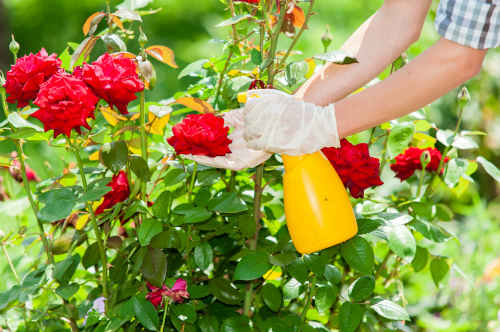How To Take Care Of Rose Plant?
Introduction:
Roses are thought to be the crown jewels of the garden. Their awesome blooms, charming fragrances, and timeless beauty have made them an image of love and elegance for centuries. However, attaining that perfect rose garden requires extra effort than simply planting and hoping for the best. For an absolute thrive, a rose garden requires devoted care and interest. In this article, we will discuss ‘How to take care of a Rose Plant Garden’ comprehensively, sharing expert guidelines and practices to ensure your roses flourish and enchant your garden for years to come.
Roses are the most stunning and versatile garden plant. They come in different forms, from patio roses to shrubs, ramblers, and climbers. Almost they all make a remarkable cut flower. Single-flowered roses are great pollinator plant life, whilst some species are utilized by leafcutter bees to make their nests. Maximum roses need solar and heavy soils to thrive, but some will grow nicely in partial coloration and poorer soils. There truly is a rose, or three, for every garden. So now here we will discuss some steps to get the best from your rose plant garden.
How To Take Care Of Rose Plant:
Choosing The Proper Roses:
Before diving into the complexity of rose care, it’s important to pick the right roses for your garden. Don’t forget elements such as weather, space, and personal choices while choosing your rose varieties. Mountain climbing roses, rambling roses, patio roses, shrub roses, and ground cover roses each have particular traits that cater to distinctive garden styles and desires.
Mountain Climbing Rose Plant:
Hiking roses are easy to domesticate. There are no roses that require 0 care, however, many human beings find mountaineering roses to be less complicated to handle and much less demanding than those that grow on timber. Mountain climbing roses are available in a wide sort of stunning sort. You may find out the precise climbing rose sorts to adorn your outside location with any colors and fragrances you like. Routine blooms are feasible depending on the cultivar. At the same time as some styles of climbing rose’s handiest bloom as soon as a season, others flower often, supplying you with a prolonged bloom length to enjoy.
Using climbing roses, you may also fill the top level of your house with a wonderful smell. You can have blooms close to your upper-story windows if you plant a rose that will grow up the wall of your home. That implies that the smell may float inside when you open your windows. You could even be able to see some of them from upstairs, depending on how numerous they are and how near to the window they are.
Rambling Rose Plant:
Rambling roses are often confused with climbing roses. Ramblers are a ways more livelily than climbers, and undergo one awesome flush of flowers, generally in June, observed by way of colorful hips. Climbing roses regularly repeat flowers and have large plant life. Rambling roses need plenty of area as they grow quickly. They’re ideal for developing up a tree or tumbling over a wall. They are best for covering an eyesore inside the garden, which includes an ugly shed or out-constructing.
A rambling rose looks terrific growing up right into a tree, specifically an apple tree, supplying plant life after the apple blossom fades however earlier than the resulting shape. In this video manual from Gardeners’ International, Monty Don shows you the way to plant distinct rambling roses – ‘Wedding Ceremony Day’ and ‘Sander’s White’. His info what situations a rambling rose wishes, how to prepare the soil, and the way deep to plant it so it settles in well over autumn and gets off to a good start in spring. You’ll additionally discover how far from the tree to plant the rose and a way to inspire it to climb up the tree:
Patio Rose Plant:
Patio roses are small sufficient to develop in pots. They are compact in dependency and thrive in lighter soils than many different rose sorts. Patio roses are not as long-lived as other varieties of rose, but they may be smooth to manage and remain compact if difficult-pruned every spring.
Shrub Roses:
Shrub roses and English roses are available in a huge range of sizes and shades – a few can develop to 2m in peak. These roses are commonly sturdy, wholesome, repeat-flowering plant life presenting color while different shrubs have completed flowering. A few shrub roses have an awesome fragrance, but if you want a scented shrub rose then English roses are for you. Shrub roses and English roses are perfect for growing in a blended border, big box, or as part of a rose lawn. Some can also study as climbers or used to grow right into a hedge.
Ground Cover Rose Plant:
Ground-cover roses have a trailing or spreading habit. They may be perfect for developing in a box, at the front of a border, or on steep banks. Moreover, many modern introductions have true ailment resistance. If given the proper situations, ground-cover roses can suppress weeds.
Getting Ready for The Perfect Surroundings For Rose Plant:
Roses grow in specific situations, so it’s important to choose the correct environment for them. Right here are some key considerations.
Daylight:
Roses require not less than 6-8 hours of direct sunlight every day. Select a sunny vicinity that gives the necessary light.
Soil Guidance For Rose Plant:
Nicely-draining soil with a pH level of around 6.0-6.5 is right for roses. Beautify the soil with natural matter like compost to improve fertility and drainage.
Planting Roses:
Plant roses in early spring or fall when the weather is moderate. Proper planting depth and spacing are important for healthy growth.
Growing Roses In Pots:
It is viable to develop roses in pots, meaning you can grow roses in even the smallest gardens. At the same time as all however rambling roses can be grown in pots, shorter developing bush varieties, or ‘patio roses’, are ideal. They’ll do exceptional in massive, deep bins – an absolute minimum of 50cm in diameter and the same in-depth – to hold their roots cool and wet for summer.
In warm, dry climates, soak the compost every three days, and feed frequently.
Watering And Feeding Rose Plant:
Right watering and feeding are essential components of rose care.
Watering Rose Plant:
Roses require consistent moisture, however, overwatering can be destructive. Water at the base of the plant to save you from fungal diseases. A drip irrigation system can provide precise and regular moisture.
Fertilizing Rose Plant:
Rose’s advantage from regular feeding. Use a balanced, gradual-release fertilizer when they begin to leaf out and again in late spring or early summer. Observe the unique fertilizer instructions on your rose range.
Pruning And Deadheading Of Rose Plant:
These play a vital role in preservation obligations to encourage healthy boom and prolific blooming.
Pruning Of Rose Plant:
Prune your rose trees in past due winter or early spring before the new increase starts. Get rid of dead, diseased, or crossing branches. Pruning promotes air stream and prevents overcrowding.
Deadheading:
Regularly dispose of spent blooms to stimulate new flower production. This no longer best keeps your rose garden looking tidy but additionally encourages repeat flowering for the duration of the season.
Disorder And Pest Management:
Roses are liable to sicknesses like black spots and powdery mold, in addition to pests together with aphids and spider mites.
Ailment control:
reveal your roses for signs of ailment and deal with them right away with appropriate fungicides if essential. Right spacing and true air circulation can also assist in preventing fungal troubles.
Pest manage:
frequently check out your roses for pests and use insecticidal cleaning soap or neem oil as needed. Encourage natural predators like ladybugs to assist in controlling pest populations.
Assisting Your Roses:
Some rose sorts, which include climbers or tall shrubs, require a guide to grow upright and preserve their form. Stakes, trellises, and fences can provide a vital guide while adding a cultured element to your garden.
Winter Protection:
In chillier climates, roses may additionally need safety all through the winter months. So, take more care of the rose Plant in winter.
Mulching:
Practice a layer of mulch across the base of the plant to insulate the roots and adjust soil temperature. So, this facilitates a shield in opposition to frost.
Wrapping Of Rose Plants:
Do not forget to wrap your rose plants in burlap or a similar material to guard them from harsh iciness conditions. Be sure to dispose of the wrapping in spring while the hazard of frost has exceeded.
Conclusion:
Take Care for Rose Plant Life is an artwork that requires determination and staying power with breathtaking beauty. By way of choosing the right roses, presenting an appropriate environment, getting to know watering and feeding, practicing the right pruning and pest management, and presenting guidance and protection as needed, you could nurture your garden’s crown jewels into colorful, flourishing specimens. Furthermore, With each season, your roses will be preserved to captivate and inspire, making your lawn a sanctuary of romance and beauty. So, roll up your sleeves, place on your gardening gloves, and embark on an adventure to create a rose garden to be the envy of your community.







